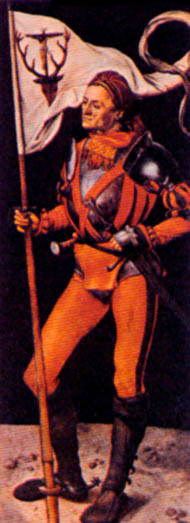 Renaissance
Man - Jan ‘03
Renaissance
Man - Jan ‘03
A quarterly column by Gene Tausk
Antique Stanleys and Historical Fencing
One
of the basic questions for practitioners of Historical Fencing (or
Historical European Martial Arts or whatever you prefer...) is why? A distant relative of mine asked me this not
too long ago. (For comparison
purposes, I point out that the person who asked me this question
enjoys collecting antique Stanley tools.
Go figure.) Source notwithstanding, however, it is a decent
question. Especially since
my relative was thinking, "what a waste of time." (Funny, I was thinking the same about his
pursuit...)
The
most common comment I get when I tell people, interested or otherwise,
about my pursuit is why don’t you study a real martial art? By “real,” they of course mean Asian. Karate, jujustsu, taekwondo, etc., these are
“real;” everything else belongs at Ye Olde Renaissance Faire next
to the guys selling “authentic” swords (...but that is another article). My standard answer is that I did study an Asian
system for a great number of years, achieved my instructor status
and went on to teach. So,
I can state with no little authority that I do have an experienced
perspective on the world of Asian martial arts.
I just find the study of European ones more interesting.
Also,
in my pursuit of historical European Swordsmanship, I also discovered
that the essence of all combat is to be found in the study of armed
combat. This should not seem so great a surprise in
retrospect. When warriors
from Miyamoto Musashi to Hans Talhoffer, not to mention those that
came before them, stated the importance of learning swordsmanship,
this should be a big clue as to just how valuable it was to learn
and practice this art. However, many contemporary Asian martial arts focus on a narrow
series of skills (hitting, kicking, grappling, etc.) because they
were developed for relevant civilian self-defense use or as sports. It is not surprising therefore, that an important
component of warrior development; namely, learning to use weapons
and the timing, distance, footwork and body-mechanics that go with
such learning and which can be applied to weaponless situations,
is absent from such narrow systems.
The same is true for narrow Western sport pursuits such as
boxing and wrestling. However, these pursuits, as effective as they
may be, do not seem to have the cultural mystique often attached
to Asian arts and therefore often are not included in such discussions.
It
can be argued, consequently, that the study of Historical Fencing
is indeed a “real” martial art.
It will just take some effort to demonstrate to the uninitiated
just how effective such arts are.
There
are also other benefits of which I told my relative. A good session of Historical Fencing practice is an intensive workout
that is both aerobic and anaerobic.
Sparring sessions, although conducted safely and with protective
equipment, contain an element of danger which sharpens reaction
time, perception, and is good for an adrenaline “rush.” In other words, Historical Fencing is a fun, effective workout.
There
is also the matter, all smugness aside, of proving the experts wrong. For years, it was commonly assumed that Europeans
had no true martial arts of which to speak, that Medieval weapons
were so heavy that only the clumsiest movements were possible, that
European armor was so heavy only people like The Rock or Schwarzeneggar
could wear such outfits and that European societies dominated the
globe due to gunpowder because European soldiers were helpless without
this technology. Thanks to the concerted efforts of groups such
as the ARMA, these ideas are being discarded.
However,
there is another factor which also influenced my decision to study
and practice Historical Fencing and that continues with me today. We often encounter the phrase “reclaiming our heritage” as practitioners
of Historical Fencing. European
martial arts are a lost part of Western heritage. The ability to reclaim these skills and techniques
brings practitioners in touch with Western history. In other words, practice makes swordsmanship
a living history. Historical
Fencing becomes Fencing, which is a word derived from “defense.” We are learning the old arts of military and
civilian defense, in other words, learning a martial art. Through practice and earnest commitment, we
take our discarded martial history and make it a living martial
art.
And
that is something at least as important as antique tools. Although it should be said, in defense of my
relative's hobby, I am unlikely to get a good deal on a sword through
a garage sale, which is something collectors of Stanley tools live
for...
GT

